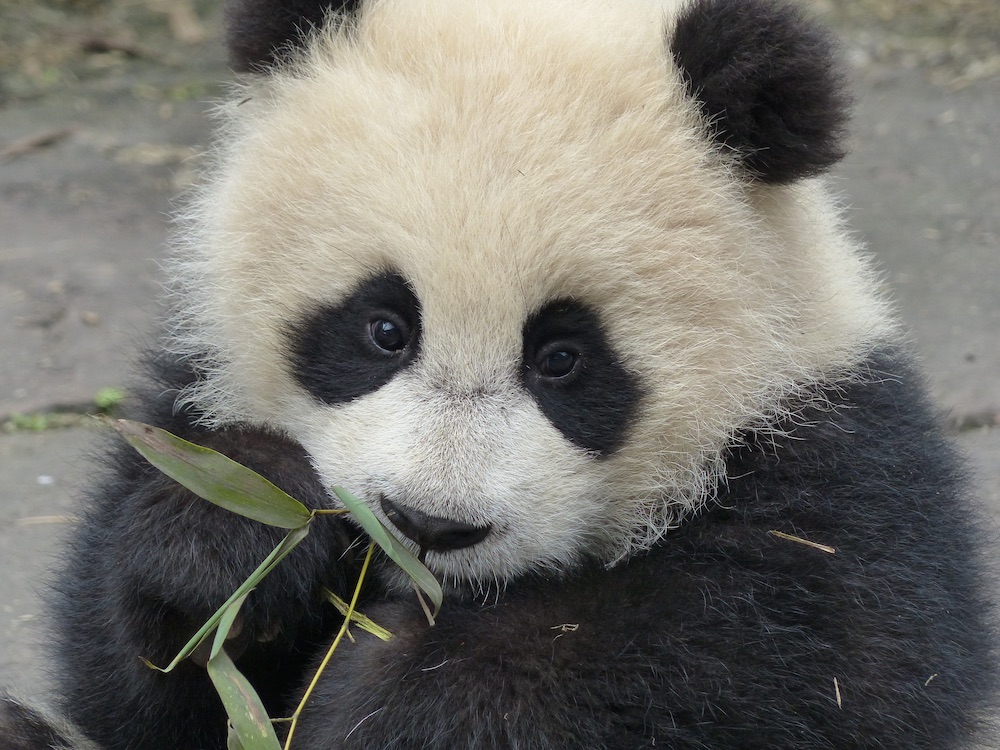The Key to Making Baby Pandas? Love

There's a secret to making panda babies, and it looks a little bit like love.
Pandas are more likely to produce young when they have a preference for the partner they're meant to mate with, a new study finds. If "love" is too strong a word for this preference, it's safe to say that panda lust, at least, plays a role in reproductive success.
In a new study published Tuesday (Dec. 15) in the journal Nature Communications, researchers allowed pandas to pick their own mates by letting them observe a pair of opposite-sex bears through barriers in a special enclosure. Bears showed their romantic interest by making chirping noises and scent-marking near their preferred partner.
This freedom of choice turned out to have a major effect on the likelihood of pandas reproducing. Overall, mutual attraction raised the rates of successful mating and cub-rearing from around zero percent when the two bears weren't interested in one another to 75 percent when they were both attracted. [Photos: A Panda Cub Grows Up]
Data broken down by gender illustrates the effect. When a female was paired for mating purposes with a male she preferred, the pair had successful sex 70 percent of the time, compared with only about 30 percent of the time when fertile females were placed with a male they weren't interested in. Females gave birth to a cub 90 percent of the time when a preferred male was the father versus 40 percent of the time when they mated with a non-preferred male. And 100 percent of pandas who copulated with a preferred male cared for their offspring, a number that dropped to 80 percent in pandas whose offspring were fathered by unappealing mates.
Male choice mattered, too — a surprising finding, given that females that do all the gestation and rearing are generally thought to be pickier than males who invest less of themselves. But panda males invest considerable time and energy in wooing females in the wild and fending off rival males, researcher Meghan Martin-Wintle of the Institute for Conservation Research, San Diego Zoo Global and PDXWildlife in Portland and her colleagues wrote. Thus, they have to be choosy about which female pandas they pursue.
When males got busy with a preferred female, they completed the sex act more than 70 percent of the time, compared with only about 30 percent of the time when mating with an unappealing female. Mating resulted in cubs almost 80 percent of the time when males picked a female they liked, but only 60 percent of the time when they had to mate with a non-preferred partner. And panda moms seemed influenced by whether the male had seen them as a good match: When males mated with a preferred partner, that female reared her cub more than 90 percent of the time. When the male fathered a cub with a female he didn't prefer, the likelihood of maternal care dropped to less than 70 percent.
Sign up for the Live Science daily newsletter now
Get the world’s most fascinating discoveries delivered straight to your inbox.
Overall, the researchers found, mutual attraction can improve panda reproduction. Giving pandas free reign over their mate choices, however, may be tougher than it sounds. Conservation breeders have to be careful to ensure genetic variability in endangered species like pandas, which are few in number. But if breeders were to pre-screen bears for genetic diversity and then check in on how the pandas respond to one another, that would allow for "the best of both worlds," Martin-Wintle and her colleagues wrote.
The research was conducted at the Bifengxia Chinese Conservation and Research Center for the Giant Panda in Sichuan, China. China is working to reintroduce pandas into the wild, a goal that will require breeding more pandas than in the past. To meet this goal, the researchers wrote, biologists will need a better of understanding of how pandas reproduce on their own in the wild.
Follow Stephanie Pappas on Twitter and Google+. Follow us @livescience, Facebook& Google+. Original article on Live Science.

Stephanie Pappas is a contributing writer for Live Science, covering topics ranging from geoscience to archaeology to the human brain and behavior. She was previously a senior writer for Live Science but is now a freelancer based in Denver, Colorado, and regularly contributes to Scientific American and The Monitor, the monthly magazine of the American Psychological Association. Stephanie received a bachelor's degree in psychology from the University of South Carolina and a graduate certificate in science communication from the University of California, Santa Cruz.
Scientists built largest brain 'connectome' to date by having a lab mouse watch 'The Matrix' and 'Star Wars'
Archaeologists may have discovered the birthplace of Alexander the Great's grandmother
Elusive neutrinos' mass just got halved — and it could mean physicists are close to solving a major cosmic mystery









